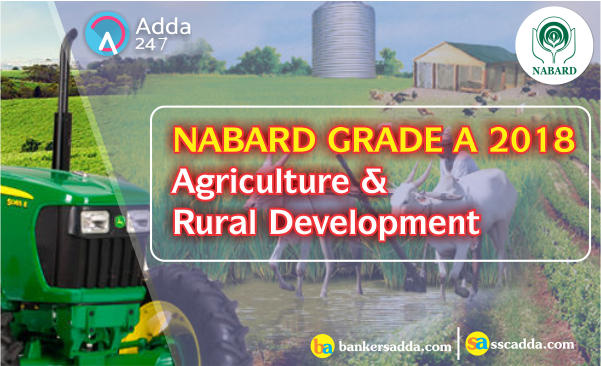
The upcoming important exams are NABARD grade A and grade B, in which there is a section Agriculture & Rural Development (with a focus on Rural India) having high weightage of 40 marks. So, for the same, it becomes really important to have an in-depth knowledge of the various terminologies and practices involved in agriculture. Further its imperative to be aware of the present scenario of Indian Agriculture and the state of Rural Development in India. To help you with this, today, we are providing you with all necessary information related to the mentioned field which will help you to fetch some good marks.
Farm Power
Farm Power is an essential input in agriculture for timely field operations for increasing production and productivity of land. Farm power is used for operating different types of machinery like tillage, planting, plant protection, harvesting and threshing machinery and other stationary jobs like operating irrigation equipment, threshers/shellers/cleaners/ graders, etc.
Sources of Farm Power
There are different sources of farm power available in India which are classified as
a) Human power
b) Animal power
c) Mechanical power (Tractors + Power tillers + Oil engines)
d) Electrical power
e) Renewable energy (Biogas + Solar energy + Wind energy)
Human Power
Human power is the main source for operating small implements and tools at the farm. Stationary work like chaff cutting, lifting, water, threshing, winnowing etc are also done by manual labour. An average man can develop maximum power of about 0.1 hp for doing farm work.
Merits: Easily available; Used for all types of work.
Demerits: Costliest power compared to all other forms of power; Very low efficiency; Requires full maintenance when not in use; Affected by weather condition and seasons.
Animal Power
Power developed by an average pair of bullocks about 1 hp for usual farm work. Bullocks are employed for all types farm work in all seasons. Besides bullocks, other animals like camels, buffaloes, horses, donkeys, mules and elephants are also used at some places. The average force a draft animal can exert is nearly one-tenth of its body weight.
Merits: Easily available; Used for all types of work; Low initial investment; Supplies manures to the field and fuels to farmers; Lives on farm products.
Demerits: Not very efficient; Seasons and weather affect the efficiency; Cannot work at a stretch; Requires full maintenance when not in use; Creates unhealthy and dirty atmosphere near the residence; Very slow in doing work.
Mechanical Power
Broadly speaking, mechanical power includes stationary oil engines, tractors, power tillers and self-propelled combines. Internal combustion engine is a good device for converting liquid fuel into useful work (mechanical work). These engines are two types
a) Spark ignition engines (Petrol or Kerosene engine)
b) Compression ignition engines (Diesel engines)
The thermal efficiency of diesel engine varies from 32 to 38 percent whereas that of petrol engine varies from 25 to 32 percent. In modern days, almost all the tractors and power tillers are operated by diesel engines. Diesel engines are used for operating irrigation pumps, flour mills, oil ghanis, cotton gins, chaff cutter, sugarcane crusher, threshers, winnowers etc.
Merits: Efficiency is high; Not affected by weather; Cannot run at a stretch; Requires less space; Cheaper form of power.
Demerits: Initial capital investment high; Fuel is costly; Repairs and maintenance needs technical knowledge.
Electrical Power
Electrical power is used mostly in the form of electrical motors on the farms. Motor is a very useful machine for farmers. It is clean, quest and smooth running. Its maintenance and operation needs less attention and care. The operating cost remains almost constant throughout its life. Electrical power is used for water pumping, diary industry, cold storage, farm product processing, fruit industry and many similar things.
Merits: Very cheap form of power; High efficiency; Can work at a stretch; Maintenance and operating cost is very low; Not affected by seasons.
Demerits: Initial capital investment high; Requires good amount of technical knowledge; If handled carelessly, it may cause great danger.
Renewable Energy
It is the energy mainly obtained from renewable sources of energy like sun, wind, biomass etc. Biogas energy, wind energy and solar energy are used in agriculture and domestic purposes with suitable devices. Renewable energy can be used for lighting, cooking, water heating, space heating, water distillation, food processing, water pumping, and electric generation. This type of energy is inexhaustible in nature.
Usage of renewable energy sources
a) Solar energy- Solar dryers, lantern, cooker, solar still, solar refrigeration, solar lighting etc
b) Wind energy- Water pumping, electricity generation etc.
c) Biomass energy- Gasifiers to produce producer gas, pyrolysis to produce liquid fuels, Biogas etc
d) Tidal energy – electricity generation
e) Geothermal energy- Heat and electricity production
Advantages of Renewable Energy
a) These sources of energy are renewable and there is no danger of depletion. These recur in nature and are inexhaustible.
b) The power plants based on renewable sources of energy don‟t have any fuel cost and hence negligible running cost.
c) Renewable are more site specific and are used for local processing and application. There is no need for transmission and distribution of power.
d) Renewables have low energy density and more or less there is no pollution or ecological balance problem.
e) Most of the devices and plants used with the renewables are simple in design and construction which are made from local materials, local skills and by local people. The use of renewable energy can help to save foreign exchange and generate local employment.
f) The rural areas and remote villages can be better served with locally available renewable sources of energy. There will be huge savings from transporting fuels or transmitting electricity from long distances.
Disadvantages of Renewable Energy
a) Low energy density of renewable sources of energy need large sizes of plant resulting in increased cost of delivered energy.
b) Intermittency and lack of dependability are the main disadvantages of renewable energy sources.
c) Low energy density also results in lower operating temperatures and hence low efficiencies.
d) Although renewables are essentially free, there is definite cost-effectiveness associated with its conversion and utilization.
e) Much of the construction materials used for renewable energy devices are themselves very energy intensive.
f) The low efficiency of these plants can result in large heat rejections and hence thermal pollution.
g) The renewable energy plants use larger land masses.
Biomass
Biomass contains stored energy from the sun. Plants absorb the sun’s energy in a process called photosynthesis. When biomass is burned, the chemical energy in biomass is released as heat. Biomass can be burned directly or converted to liquid biofuels or biogas that can be burned as fuels.
Four types of biomass are:
a) Wood and agricultural products: Most biomass used today is homegrown energy. Wood-logs, chips, bark, and sawdust-accounts for about 79 percent of biomass energy. But any organic matter can produce biomass energy. Other biomass sources include agricultural waste products like fruit pits and corn cobs.
b) Solid waste: There is nothing new about people burning trash. What’s new is burning trash to generate electricity. This turns waste into a usable form of energy. A ton (2,000 pounds) of garbage contains about as much heat energy, as pounds of coal.
c) Landfill gas: Bacteria and fungi eat dead plants and animals, causing them to rot or decay. Even though this natural process is slowed in the artificial environment of a landfill, methane gas is still produced as the waste decays. Landfills can collect the methane gas, purify it, and then use it as an energy source. Methane, which is the same thing as natural gas, is a good energy source.
d) Alcohol fuels: Wheat, corn, and other crops can be converted into a variety of liquid fuels including ethanol and methanol.
Advantages
1) Biomass used as a fuel reduces need for fossil fuels for the production of heat, steam, and electricity for residential, industrial and agricultural use.
2) Biomass is always available and can be produced as a renewable resource.
3) Biomass fuel from agriculture wastes maybe a secondary product that adds value to agricultural crop.
4) Growing Biomass crops produce oxygen and use up carbon dioxide.
5) The use of waste materials reduce landfill disposal and makes more space for everything else.
6) Carbon Dioxide which is released when Biomass fuel is burned, is taken in by plants.
7) Less money spent on foreign oil.
Disadvantages
1) Agricultural wastes will not be available if the basic crop is no longer grown.
2) Additional work is needed in areas such as harvesting methods.
3) Land used for energy crops may be in demand for other purposes, such as farming, conservation, housing, resort or agricultural use.
4) Some Biomass conversion projects are from animal wastes and are relatively small and therefore are limited.
5) Research is needed to reduce the costs of production of Biomass-based fuels.
6) Is in some cases is a major cause of pollution.
You may also like to Read:



 The Hindu Review October 2022: Download ...
The Hindu Review October 2022: Download ...
 JAIIB PPB 2024 Exam Readiness Test: Atte...
JAIIB PPB 2024 Exam Readiness Test: Atte...
 Employment News 2024, Download Weekly PD...
Employment News 2024, Download Weekly PD...



